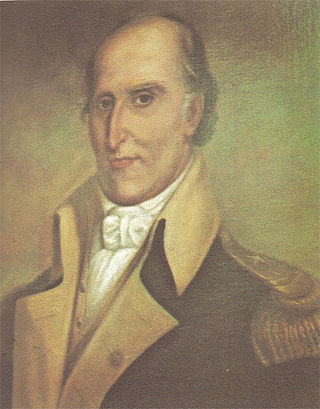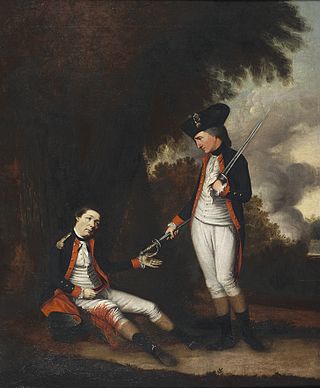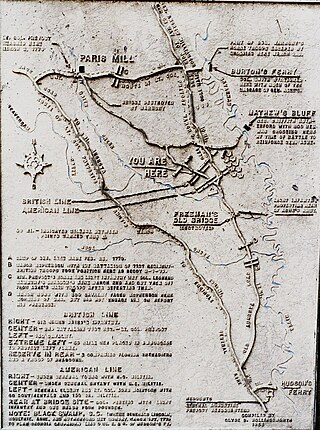
Robert Howe was a Continental Army general from the Province of North Carolina during the American Revolutionary War. The descendant of a prominent family in North Carolina, Howe was one of five generals, and the only major general, in the Continental Army from that state. He also played a role in the colonial and state governments of North Carolina, serving in the legislative bodies of both.
Fort Tonyn, named for General Patrick Tonyn, was located in present-day Nassau County, Florida, near the hamlet of Mills's Ferry, about 25 miles up the St. Marys River. The fort was unremarkable in its day, seeing little action, and apparently was not even recognized as a fort by the British; the name appears to have been used by the Americans for this British outpost. It is remembered chiefly because it served as a way station in the only substantial campaign Florida saw during the Revolution. General Robert Howe camped near the fort with some 400 men on June 28, 1778, forcing the withdrawal of Lieutenant Thomas Brown and his loyalist East Florida Rangers, who were stationed there as the front line of defense for British East Florida. They burned the fort and retreated into Cabbage Swamp. These events occurred just prior to Colonel Elijah Clarke leading his Continental Army troops to defeat at the Battle of Alligator Bridge on June 30, the only major engagement in an unsuccessful campaign to conquer British East Florida during the American Revolutionary War.

The siege of Savannah or the Second Battle of Savannah was an encounter of the American Revolutionary War (1775–1783) in 1779. The year before, the city of Savannah, Georgia, had been captured by a British expeditionary corps under Lieutenant-Colonel Archibald Campbell. The siege itself consisted of a joint Franco-American attempt to retake Savannah, from September 16 to October 18, 1779. On October 9 a major assault against the British siege works failed. During the attack, Polish nobleman Count Casimir Pulaski, leading the combined cavalry forces on the American side, was mortally wounded. With the failure of the joint attack, the siege was abandoned, and the British remained in control of Savannah until July 1782, near the end of the war.

Samuel Elbert was an American merchant, soldier, slave owner, and politician from Savannah, Georgia.

The Battle of Kettle Creek was the first major victory for Patriots in the back country of Georgia during the American Revolutionary War that took place on February 14, 1779. It was fought in Wilkes County about eleven miles (18 km) from present-day Washington, Georgia. A militia force of Patriots decisively defeated and scattered a Loyalist militia force that was on its way to British-controlled Augusta.

The Battle of Moore's Creek Bridge was a minor conflict of the American Revolutionary War fought near Wilmington, North Carolina, on February 27, 1776. The victory of the North Carolina Provincial Congress' militia force over British governor Josiah Martin's and Tristan Worsley's reinforcements at Moore's was a turning point in the war; American independence was declared less than five months later.

The southern theater of the American Revolutionary War was the central theater of military operations in the second half of the American Revolutionary War, 1778–1781. It encompassed engagements primarily in Virginia, Georgia, North Carolina, and South Carolina. Tactics consisted of both strategic battles and guerrilla warfare.
The Battle of Thomas Creek, also known as the Thomas Creek Massacre, was an ambush of a small detachment of mounted Georgia Militia by a mixed force of British soldiers, Loyalist militia, and British-allied Indians on May 17, 1777 near the mouth of Thomas Creek in northern East Florida. The encounter was the only major engagement in the second of three failed attempts by American forces to invade East Florida in the early years of the American Revolutionary War.
Sawpit Bluff was a small settlement in East Florida during the American Revolutionary War on the site of a plantation at the mouth of Sawpit Creek where it discharges into Nassau Sound opposite the south end of Amelia Island. It was the location of a proposed rendezvous between mounted militia from Sunbury, Georgia and Continental troops under the command of Lt. Col. Samuel Elbert during the second invasion of Florida in May 1777.

The Battle of Stono Ferry was an American Revolutionary War battle, fought on June 20, 1779, near Charleston, South Carolina. The rear guard from a British expedition retreating from an aborted attempt to take Charleston held off an assault by poorly trained militia forces under American General Benjamin Lincoln.

The Battle of Brier Creek was an American Revolutionary War battle fought on March 3, 1779, near the confluence of Brier Creek with the Savannah River in eastern Georgia. An American Patriot force consisting principally of militia from North Carolina and Georgia along with some Continental Army troops were defeated by British forces, suffering significant casualties. The rout damaged Patriot morale.

The Capture of Savannah was a battle of the American Revolutionary War fought on December 29, 1778. It pitted an American garrison of Continental Army and militia units against a British invasion force commanded by Lieutenant-Colonel Archibald Campbell. The capture of the city led to an extended occupation and was the opening move in the British southern strategy to regain control of the rebellious Southern Colonies by appealing to the relatively strong Loyalist sentiment there.

The Battle of Beaufort, also known as the Battle of Port Royal Island, was fought on February 3, 1779, near Beaufort, South Carolina, during the American Revolutionary War. The battle took place not long after British forces consolidated control around Savannah, Georgia, which they had captured in December 1778.
The siege of Augusta took place between May 22, 1781, and June 6, 1781. American Patriot forces, led by Brigadier General Andrew Pickens and Lieutenant Colonel Henry "Light Horse Harry" Lee, were successful in capturing Augusta, Georgia held by British loyalist militia. Fort Cornwallis, the primary British defence, was successfully exposed to cannon fire by the construction of a tower 30 feet (9.1 m) high on which the Americans mounted a small cannon. The British surrendered on June 6.
The Province of Georgia was a significant battleground in the American Revolution. Its population was at first divided about exactly how to respond to revolutionary activities and heightened tensions in other provinces. Georgia was the only colony not present in the First Continental Congress in 1774. When violence broke out in 1775, radical Patriots took control of the provincial government, and drove many Loyalists out of the province. Georgia subsequently took part to the Second Continental Congress with the other colonies. In 1776 and 1778, Georgia served as the staging ground for several important raids into British-controlled Florida. The British army captured Savannah in 1778, and the American and French forces failed to recapture the city during the Siege of Savannah in 1779. Georgia remained under British control until their evacuation from Savannah in 1782.

The siege of Savage's Old Fields was an encounter between Patriot and Loyalist forces in the back country town of Ninety Six, South Carolina, early in the American Revolutionary War. It was the first major conflict in South Carolina in the war, having been preceded by bloodless seizures of several military fortifications in the province.

Colonists who supported the British cause in the American Revolution were Loyalists, often called Tories, or, occasionally, Royalists or King's Men. George Washington's winning side in the war called themselves "Patriots", and in this article Americans on the revolutionary side are called Patriots. For a detailed analysis of the psychology and social origins of the Loyalists, see Loyalist.

The British Army during the American Revolutionary War served for eight years in the American Revolutionary War, which was fought throughout North America, the Caribbean, and elsewhere from April 19, 1775, to September 3, 1783. The war formally commenced at the Battles of Lexington and Concord in present-day Massachusetts. Two months later, in June 1775, the Second Continental Congress, gathered in the revolutionary capital of Philadelphia, appointed George Washington to organize patriot militias into the Continental Army and lead them in a war against the British Army. The following year, in July 1776, the Second Continental Congress, representing the Thirteen Colonies, declared themselves free and independent from colonial governance.
Daniel McGirt, also given as McGirtt or McGirth,, a native of the Camden District in South Carolina, was the leader of an outlaw gang that operated in northern Florida and southern Georgia during the latter 1700s. Mostly uneducated, he made a living as a hunter and trapper until the American Revolutionary War broke out, whereupon he served for a while as a scout for the Continental Army, then switched sides, and became one of the more picturesque minor figures of the war.
The King's Carolina Rangers (KCR) was a loyalist militia regiment active during the American War of Independence. The KCR was composed of nine infantry companies, of which one was converted into a troop of dragoons in 1782. The unit primarily saw action in the South Carolina and Georgia theatres of the conflict.












